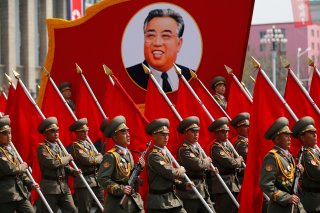How Has Iran Become a Military Powerhouse? Ask North Korea.
The Pyongyang-Tehran arms trade has only ballooned with the gradual implementation of international sanctions against North Korea since 2006. The two rogue states have allegedly exchanged nuclear secrets, including the relevant mathematical formulas and key testing data. There is also mounting, though largely circumstantial, evidence that they are exploring a potential deal for centrifuges and enriched uranium transfers.
The U.S. State Department is stepping up its efforts to tighten the sanctions regime arrayed against Iran, drawing renewed attention to the thriving arms trade between Pyongyang and Tehran.
The lucrative military partnership between Iran and North Korea began in the 1980’s, when North Korea first established itself as a legal arms exporter across the third and developing world. North Korea became a major weapons supplier to Iran during the Iran-Iraq war, shipping a wide range of small arms, tanks, artillery systems, and heavy ordnance. Tehran also solicited the aid of North Korean military advisors to train Iran’s armed forces in the use of portable surface-to-air missile systems and other advanced weaponry. It has been estimated that, by the war’s end in 1988, around 300 North Korea military advisors were operating in Iran. To be sure, Pyongyang was not particularly invested in that conflict’s outcome; even as they openly aided Tehran, North Korean diplomats were quietly making overtures to Baghdad. As with its many ongoing weapons sales in Africa, North Korea was primarily driven by the profit motive— particularly, the need to maintain its foreign currency reserves.
In the following decade, the trade relationship shifted to missile technology. The precise extent of Iran-North Korea missile cooperation remains unclear, but there is widespread consensus that technology transfers and direct missile sales played a seminal role in helping to get Iran’s nascent missile program off the ground. A 1993 U.S. intelligence assessment called Iran “one of North Korea’s best customers for ballistic missiles and related technology.” Tehran was an early client for North Korea’s Hwasong-7 medium-range ballistic missile (MRBM), later using it as the design foundation for their homegrown Shahab-3 MRBM. Even as it continued to purchase North Korean missile technology, Iran developed a growing interest in midget submarines. It is widely believed that Iran’s infamous Ghadir-class submarines— a crucial part of the Iranian Navy’s presence in the Persian Gulf and capacity to stage anti-access/area-denial (A2/AD) operations across the Hormuz Strait—are a licensed copy of North Korea’s Yono-class vessels, several of which were purchased by Iran in the early 2000’s.
The Pyongyang-Tehran arms trade has only ballooned with the gradual implementation of international sanctions against North Korea since 2006. The two rogue states have allegedly exchanged nuclear secrets, including the relevant mathematical formulas and key testing data. There is also mounting, though largely circumstantial, evidence that they are exploring a potential deal for centrifuges and enriched uranium transfers.
Most recently, the State and Treasury Departments have accused Iranian defense conglomerate Shahid Movahed Industries of cooperating with North Korea on unspecified “long-range missile development projects.” These developments come on the heels of Korea experts’ well-grounded suspicions that North Korea proliferated Hwasong 12/14/15 IRBM and ICBM technology to Iran in recent years.
The United States has made little progress in stemming the ongoing arms trade and robust technical-military cooperation between Iran and North Korea. The State Department promises more sanctions, but both states have proven remarkably adept at skirting the international sanctions regime. Over the past decade, Pyongyang has established an elaborate network of foreign proxies and elaborate ship-to-ship transfers that have kept North Korean arms flowing across the developing world. Meanwhile, a diplomatic solution is even more dubious. With the 2015 Iran deal all but dead and normalization talks with North Korea on prolonged hiatus until at least after the U.S. presidential election, Washington seemingly lacks the leverage to either drive a wedge in North Korea-Iranian military cooperation or to impose meaningful costs on it.
Mark Episkopos is a frequent contributor to the National Interest and now a national security reporter for this publication.

